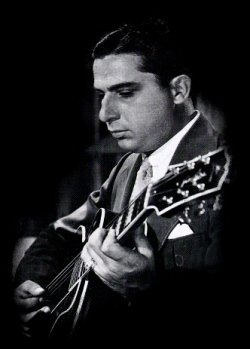Lang was born in 1902, a second generation Italian, whose father was a luthier. There being a lot of prejudice about Italian immigrants at the time, he changed his name from Salvatore Massaro to Eddie Lang. (Sacco and Vanzetti were executed for murder in 1927, not because the evidence was good, but because they were Italians, immigrants, anarchists, and poor).
The rise of the guitar
In the New Orleans style, many guitarists doubled on banjo. Johnny St Cyr, whom we’ve heard with Louis and Jelly Roll, was one such player. But once in Chicago, guitar started to become the favoured instrument, and banjo went into decline. Thus many of the Chicago bands we’ll hear have guitar rather than banjo, and from now on guitar will become an important part of a jazz rhythm section.
Lead instrument
But as well as a rhythm instrument, Lang shows guitar can be a lead instrument. His fluid, inventive style, and mastery of the fret-board, paves the way for players like Charlie Christian and Django Reinhart. With recording technology improving, he is able to play single string solos and be picked up by the microphones.
Love of blues
Lang brings a European folk dimension to jazz, especially in his partnership with Joe Venuti, but he also has a deep love of blues. He was in huge demand as a sideman by both black and white groups, covering the range from big band jazz to accompanying blues singers.
Here he is with Louis Armstrong in 1929. He begins the piece, and then his solo is heard from about 0:58. Listen to his bluesy bent notes:
And here he is with Bix in 1927:
Listen to his bluesy intro, him trading phrases with Bix, and his clean, lyrical counter-melodies underpinning Tram’s sax, and the outro phrases with Bix.
Debt to New Orleans string bands
A lot of where Eddie was coming from can be heard in the early New Orleans string bands, and he fitted seamlessly with Lonnie Johnson’s band on a number of occasions, as well as recording a number of duets with Johnson, often destined for record machines at juke joints. The record company assumed the world wasn’t ready for a mixed race duo, so he often went under the pseudonym Blind Willie Dunn. (He was, after all, no stranger to changing his name to avoid prejudice).
Here’s Eddie with legendary New Orleans guitarist, Lonnie Johnson in 1929.
Lonnie Johnson had fond memories of his friend, recalling: “He was the nicest man I ever worked with. Eddie and I got together many a time in the old Okeh record studios in New York, and we even made many sides together with just two guitars. I valued those records more than anything in my life. [...] Eddie was a fine man. He never argued. He didn’t tell me what to do. He would ask me. [...] I’ve never seen a cat like him since. He could play guitar better than anyone I know. And I’ve seen plenty in my day”. (Hear Me Talkin’ To Ya, pp271/272).
He is best known, though, for his partnership with violin player, Joe Venuti, in Joe’s Blue Four, and as a duo.
His solo comes in at about 2:10.
Brief clip of Eddie and Joe playing together:
Lang died as a result of a botched tonsillectomy in 1933, aged only 30. He spoke with a croak, and Bing Crosby had recommended the operation to him in the hope that Lang could get into movies.
Here’s his own composition, Eddie’s Twister:
Eddie on CD:
You can hear Eddie on countless CDs, with Bix, with Hoagy Carmichael, in Paul Whiteman’s band, backing Bing Crosby, and Bessie Smith, and with Louis Armstrong, as well as with Lonnie Johnson. But the compilation that Morton and Cook recommend is The Quintessential Eddie Lang 1925 – 1932 on the Timeless Historical imprint of Timeless Records.
But also consider A Handful of Riffs, on the Asv Living Era label:




No comments:
Post a Comment